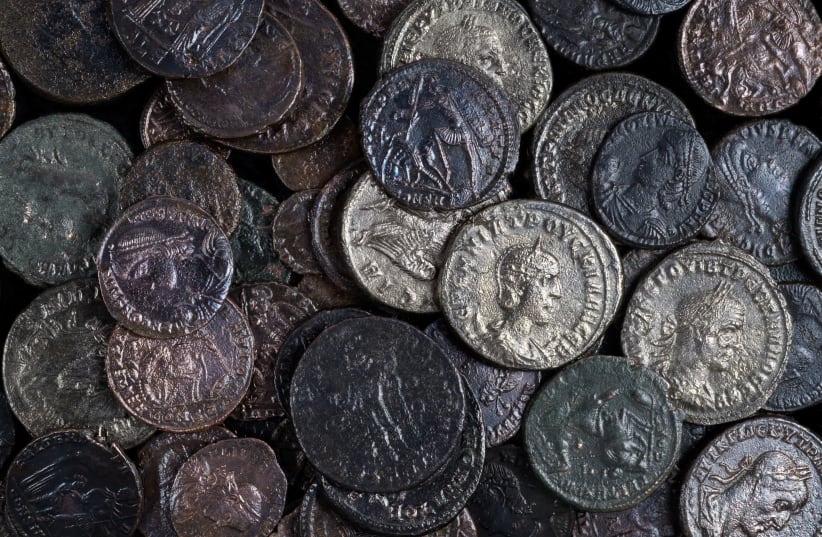The Israel Antiquities Authority (IAA) and the Lod Municipality discovered them by chance during excavations of a destroyed Jewish public building. Experts said they were evidence of the last Jewish revolt against Roman rule in Israel – 1,650 years ago.
The dramatic discovery is the first-ever evidence in Lod of the Gallus Revolt, the last Jewish resistance against Roman rule, between 351 and 354 CE.
The excavation was carried out on Nordau Street in the building from the late Roman-early Byzantine period that suffered violent destruction. Presumably, the coins, dating from 221 to 354 CE, were deliberately placed there in the hopes that the owner would return to collect them when the situation calmed down.
There is very little written evidence about the Gallus Revolt. However, texts indicate that the forces of Roman Caesar Flavius Constantinus Gallus destroyed major Jewish communities such as Lod, Zipori, and Tiberias.
Among the various finds in the building were impressive stone and marble artifacts, along with Greek, Hebrew, and Latin inscriptions, including one bearing the name of a Jewish man from a priestly family, which is still under examination.
These inscriptions, coupled with the complete absence of pig bones from the bone assemblage uncovered on the site, attest to this building’s association with the Jewish community.
'An exciting, very emotionally moving find'
According to IAA site excavators Shahar Krispin and Mor Viezel, “In all likelihood, this is a magnificent Jewish building that housed the city’s elders. From Talmudic writings, we know that Lod was a most significant Jewish center in the aftermath of the Second Temple’s destruction in Jerusalem. Some of the renowned ‘Sages of Lod’ are Rabbi Eliezer ben Horkanos, Rabbi Tarfon, Rabbi Akiva, Rabbi Yosi Ha’Galili, and many more.
“The building, destroyed down to its very foundations, is a clear indication that the revolt was forcefully put down with violence and cruelty and was not simply a local uprising event, as some earlier studies contended. This is the singular witness, thus far, to the extent and power of this revolt in Lod, which is located in the country’s center.”
IAA council head Prof. Joshua Schwartz, who studies Talmudic-period Lod, noted that “it’s hard to know if this magnificent building served as synagogue, study hall, meeting hall of the elders, or all three of these functions as one.
But what is clear is that the building’s size, the coin hoard, and the assemblage of archaeological finds produced by the excavation fit well Lod/Diospolis’s description, in both Jewish and non-Jewish sources, as a center of Torah-true Jewish life in the Mishna and Talmud periods. Lod’s role as a leading community with elders continued from after the destruction through to this moment, when it was cruelly cut down in the Gallus Revolt.”
IAA director Eli Escuzido concluded that “the impressive finds uncovered here reinforce our responsibility to investigate and to conserve Lod’s history and rich heritage. Along with the city’s new exhibition center of the beautiful Lod mosaic, we now bring this building to the awareness of the general public.”
Lod Mayor Yair Revivo added that “this is an exciting and very emotionally moving find, another link in the chain of Lod’s Tannaitic period heritage as host to the authors of the Mishna and Lod’s Jewish history. The finds in the area prove that Lod is one of the oldest cities in the world. We wish to thank the IAA for revealing our city’s past glory. I believe that now that it is uncovered, this site will bring many tourists and visitors to the city. Lod is connecting to its past and is looking forward to a bright future.”
The findings will be published as part of the Central Israel Region Archaeological Conference, which will be held at Tel Aviv’s Eretz Yisrael Museum on June 20 and jointly hosted by Tel Aviv University, Bar-Ilan University, and the (IAA). The event is open to the public at no charge. Details can be found on the Israel Antiquities Authority website.

